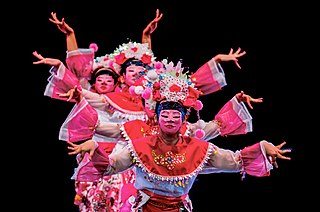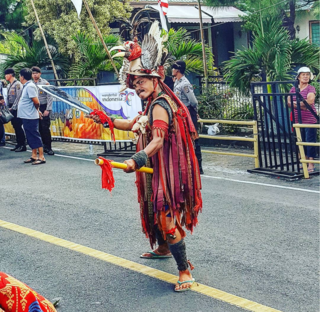 W
WThis is list of Indonesian dances.
 W
WBalinese dance is an ancient dance tradition that is part of the religious and artistic expression among the Balinese people of Bali island, Indonesia. Balinese dance is dynamic, angular and intensely expressive. Balinese dancers express the stories of dance-drama through the bodily gestures including gestures of fingers, hands, head and eyes.
 W
WThe Betawi mask dance is a theatrical form of dance-drama of Betawi people in Jakarta, Indonesia. This dance-drama encompasses dance, music, bebodoran (comedy) and lakon (drama). The Betawi mask dance demonstrates the theme of Betawi society life which represented in the form of dance and drama. It is called mask dance because the dancers using topeng (mask) during dancing which Betawi people believed that the topeng has magical powers.
 W
WCakalele dance is a war dance from North and Central Maluku in Indonesia. Hybrid versions also exist among the aboriginals of Sulawesi, Timor, and the Tanimbar Islands. The dance is performed by men, two of whom represent opposing captains or leaders while the others are the warriors supporting them. After an opening ritual, the captains engage in a mock-duel with a spear (sanokat) and long knife (lopu) while their supporters use a long knife in the right hand and a narrow wooden shield in the left hand. The shield is referred to as a salawaku, or by a local name such as the Tobelo o dadatoko. The cakalele originated as a way for the warriors to celebrate after a successful raid. Dancers dress in full warrior costume and are backed by the rhythm of the drum and gong (tifa) and fife (sulin).
 W
WDance in Indonesia reflects the country's diversity of ethnicities and cultures. There are more than 1,300 ethnic groups in Indonesia. Austronesian roots and Melanesian tribal forms are visible, and influences ranging from neighboring Asian and even western styles through colonization. Each ethnic group has its own dances: there are more than 3,000 original dance forms in Indonesia. The old traditions of dance and drama are being preserved in the many dance schools which flourish not only in the courts but also in the modern, government-run or supervised art academies.
 W
WGandrung is a traditional dance from Indonesia. Gandrung has many variations and is popular in Bali, Lombok and Eastern Java among the Balinese, Sasak and Javanese. The most popular variation is gandrung from the Banyuwangi region in the eastern peninsula of Java, so much that the city is often referred as Kota Gandrung or "the city of gandrung".
 W
WGendang Beleq dance is a sacred folk dance tradition of Sasak people of Lombok in West Nusa Tenggara, Indonesia. This dance demonstrates dance performance with big drums, called gendang beleq.
 W
WIndang also called Dindin badindin is a traditional Minangkabau Islamic dance originating from West Sumatra, Indonesia. Indang dance grows and develops in the Minangkabau community as a portrayal of the arrival of Islam in West Sumatra in the 13th century.
 W
WJaipongan, also known as Jaipong, is a popular traditional dance of Sundanese people, West Java, Indonesia. The dance was created by Gugum Gumbira, based on traditional Sundanese Ketuk Tilu music and Pencak Silat movements.
 W
WJavanese dance is the dances and art forms that were created and influenced by Javanese culture. Javanese dance movement is controlled, deliberate and refined. Javanese art often displays a finesse, and at the same time a serene composure which is elevated far above everything mundane. Javanese dance is usually associated with courtly, refined and sophisticated culture of the Javanese kratons, such as the bedhaya and srimpi dance. However, in a wider sense, Javanese dance also includes the dances of Javanese commoners and villagers such as ronggeng, tayub, reog, and jaran kepang.
 W
WKabasaran is a traditional Minahasan war dance from North Sulawesi in Indonesia. It is performed by several men clad in red costumes, wielding a sword with a shield or a spear. The dancers are called kawasalan, which implies imitating like a pair of fighter cocks. the word kabasaran is derived from kawasalan.
 W
WKuda Lumping is a traditional Javanese dance originated from Ponorogo, East Java, Indonesia depicting a group of horsemen. Dancers "ride" horses made from woven bamboo and decorated with colorful paints and cloth. Generally, the dance portrays troops riding horses, but another type of Kuda Lumping performance also incorporates trances and magic tricks. When the "possessed" dancer is performing the dance in trance conditions, he can display unusual abilities, such as eating glass and resistance to the effects of whipping or hot coals.
 W
WMak Yong is a traditional form of dance-drama from northern Malaysia, particularly the state of Kelantan. It was banned by the Pan-Malaysian Islamic Party because of its animist and Hindu-Buddhist roots which pre-date Islam in the Asian region by far. The late Cik Ning was a leading Mak Yong performer in the 1980s. In 2005, UNESCO declared Mak Yong theatre a "Masterpieces of the Oral and Intangible Heritage of Humanity".
 W
WMoraego, is the name of a traditional and ritual dance in Central Sulawesi.
 W
WNgesti Pandawa is a professional wayang wong or wayang orang art company located in Semarang. The Ngesti Pandawa wayang orang is housed in the Ki Narto Sabdho Hall in Taman Budaya Raden Saleh or the Taman Raden Saleh Cultural Complex at Jalan Sriwijaya 29, Semarang City, Central Java Province, Indonesia. Ngesti Pandawa is one of three surviving wayang orang troupes in Indonesia, besides Wayang Orang Sriwedari in Taman Sriwedari Solo and Wayang Orang Bharata in Jakarta. It is hoped that wayang orang will again be able to entertain generations of audiences while sending a timeless moral message.
 W
WRamayana Ballet Prambanan is a visualization of Kakawin Ramayana, Javanese version of Ramayana story, performed near the Prambanan temple, Indonesia. The Ramayana Ballet at the Prambanan isn't like the Western ballet performance, It's more like the Wayang wong.
 W
WRodat is an Indonesian folk dance believed to have originated from the Middle East and was spread to the Indonesian archipelago by the Acehnese traders in the beginning of 19th century. Rodat may have been the combination of two words hadrat Baghdad which means zikir Baghdad.
 W
WRonggeng is a type of Javanese dance in which couples exchange poetic verses as they dance to the music of a rebab or violin and a gong. Ronggeng might have originated from Java in Indonesia.
 W
WSundanese dances is a dance tradition that is a part of ritual, artistic expression as well as entertainment and social conduct among the Sundanese people of West Java and Banten, Indonesia. Sundanese dance is usually cheerful, dynamic and expressive, with flowing movements in-sync with the beat of kendang accompanied with Gamelan degung music ensemble.
 W
WTopeng is a dramatic form of Indonesian dance in which one or more mask-wearing, ornately costumed performers interpret traditional narratives concerning fabled kings, heroes and myths, accompanied by gamelan or other traditional music instruments.
 W
WWayang wong, also known as wayang orang, is a type of classical Javanese and Balinese dance theatrical performance with themes taken from episodes of the Ramayana or Mahabharata. Performances are stylised, reflecting Javanese court culture:Wayang wong dance drama in the central Javanese Kraton of Yogyakarta represents the epitome of Javanese aesthetic unity. It is total theatre involving dance, drama, music, visual arts, language, and literature. A highly cultured sense of formality permeates every aspect of its presentation.
 W
WZapin is of the most popular dance and musical forms in traditional Malay performing arts. Elegant dance movements are choreographed to the lively melodies, which are performed using musical instruments such as the gambus, accordion and rebana. It is believed to have been introduced by Persians and Arabs Muslim missionaries from the Middle East to Malay Archipelago around the fourteenth century where back then only males were allowed to perform; nowadays, female dancers are included. It used to be performed exclusively for religious ceremonies but through the years it has become a form of traditional entertainment, hence the participation of female dancers is allowed.